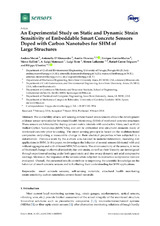An Experimental Study on Static and Dynamic Strain Sensitivity of Embeddable Smart Concrete Sensors Doped with Carbon Nanotubes for SHM of Large Structures
Autor
Meoni, Andrea
D’Alessandro, Antonella
Downey, Austin
García Macías, Enrique
Rallini, Marco
Materazzi, A. Luigi
Torre, Luigi
Laflamme, Simon
Castro Triguero, Rafael
Ubertini, Filippo
Editor
MDPIFecha
2018Materia
Smart concrete sensorsSelf-sensing materials
Structural health monitoring
Strain sensitivity
Carbon nanotubes
Cement-based materials
METS:
Mostrar el registro METSPREMIS:
Mostrar el registro PREMISMetadatos
Mostrar el registro completo del ítemResumen
The availability of new self-sensing cement-based strain sensors allows the development
of dense sensor networks for Structural Health Monitoring (SHM) of reinforced concrete structures.
These sensors are fabricated by doping cement-matrix mterials with conductive fillers, such as Multi
Walled Carbon Nanotubes (MWCNTs), and can be embedded into structural elements made of
reinforced concrete prior to casting. The strain sensing principle is based on the multifunctional
composites outputting a measurable change in their electrical properties when subjected to a
deformation. Previous work by the authors was devoted to material fabrication, modeling and
applications in SHM. In this paper, we investigate the behavior of several sensors fabricated with and
without aggregates and with different MWCNT contents. The strain sensitivity of the sensors, in terms
of fractional change in electrical resistivity for unit strain, as well as their linearity are investigated
through experimental testing under both quasi-static and sine-sweep dynamic uni-axial compressive
loadings. Moreover, the responses of the sensors when subjected to destructive compressive tests are
evaluated. Overall, the presented results contribute to improving the scientific knowledge on the
behavior of smart concrete sensors and to furthering their understanding for SHM applications.

